CHCDIS007: Assessment on Empowering Individuals with Disabilities
VerifiedAdded on 2023/01/13
|75
|8277
|58
Homework Assignment
AI Summary
This document presents a comprehensive assessment for the CHCDIS007 unit, focusing on facilitating the empowerment of people with a disability. The assessment covers various aspects, including the historical context of disability, the role of the United Nations, and the understanding of human rights. It explores different models of disability, myths, and facts surrounding disabilities. A significant portion of the assessment is dedicated to a case study involving a 17-year-old boy with cerebral palsy, examining his rights, the responsibilities of a residential care facility, and advocacy strategies. The assessment includes multiple activities with questions related to the case study, requiring the student to analyze the situation, identify breaches of rights, and suggest appropriate responses. The document also includes student assessment records, pre-assessment checklists, and student cover pages. The assessment encompasses knowledge questions, research work, and observation of practical skills, providing a holistic evaluation of the student's understanding and application of the unit's concepts. The assessment also includes feedback from the assessor and covers various activities related to the student's understanding of the topic.

Paraphrase This Document
Need a fresh take? Get an instant paraphrase of this document with our AI Paraphraser

1. Table of Contents
1.Table of Contents...............................................................................................................2
2. to Student...........................................................................................................................4
CHCDIS007 Facilitate the empowerment of people with a disability...............................4
3.Student Overall Assessment Record Sheet....................................................................6
4.Pre Assessment Checklist.................................................................................................8
5.Student Assessment Cover page...................................................................................10
Activity 1A – PC 1.1........................................................................................................12
Activity 1B – PC 1.2........................................................................................................14
Activity 1C – PC 1.3........................................................................................................15
Activity 1D – PC 1.4........................................................................................................17
1.What would you do to help empower and advocate disability rights for Chris and
his family? ...........................................................................................................................17
2.Provide three ways of how you could get involved with advocating for disability
services.................................................................................................................................17
Activity 2A – PC 2.1........................................................................................................19
1.What are Chris’s rights? .................................................................................................19
6.Are the rights of Chris and his family being exercised? Explain your answer. .......19
Activity 2B – PC 2.2........................................................................................................20
What is the responsibility of the residential care facility? How should they have
responded?..........................................................................................................................20
Activity 2C – PC 2.3........................................................................................................21
Activity 2D – PC 2.4........................................................................................................23
What breach has occurred in this situation? ..................................................................24
Activity 2E – PC 2.5........................................................................................................25
Activity 3A – PC 3.1........................................................................................................26
Activity 3B – PC 3.2........................................................................................................29
Activity 3C – PC 3.3........................................................................................................30
Activity 3D – PC 3.4........................................................................................................32
Activity 3E – PC 3.5........................................................................................................34
Activity 3F – PC 3.6.........................................................................................................35
7.Assessment 1: Underpinning Knowledge Questions Assessors Feedback ............37
9.Assessment 2: Research Work/Project (Q & A)............................................................39
10.Assessment 2: Research Work/Project Assessor Feedback....................................50
1.Table of Contents...............................................................................................................2
2. to Student...........................................................................................................................4
CHCDIS007 Facilitate the empowerment of people with a disability...............................4
3.Student Overall Assessment Record Sheet....................................................................6
4.Pre Assessment Checklist.................................................................................................8
5.Student Assessment Cover page...................................................................................10
Activity 1A – PC 1.1........................................................................................................12
Activity 1B – PC 1.2........................................................................................................14
Activity 1C – PC 1.3........................................................................................................15
Activity 1D – PC 1.4........................................................................................................17
1.What would you do to help empower and advocate disability rights for Chris and
his family? ...........................................................................................................................17
2.Provide three ways of how you could get involved with advocating for disability
services.................................................................................................................................17
Activity 2A – PC 2.1........................................................................................................19
1.What are Chris’s rights? .................................................................................................19
6.Are the rights of Chris and his family being exercised? Explain your answer. .......19
Activity 2B – PC 2.2........................................................................................................20
What is the responsibility of the residential care facility? How should they have
responded?..........................................................................................................................20
Activity 2C – PC 2.3........................................................................................................21
Activity 2D – PC 2.4........................................................................................................23
What breach has occurred in this situation? ..................................................................24
Activity 2E – PC 2.5........................................................................................................25
Activity 3A – PC 3.1........................................................................................................26
Activity 3B – PC 3.2........................................................................................................29
Activity 3C – PC 3.3........................................................................................................30
Activity 3D – PC 3.4........................................................................................................32
Activity 3E – PC 3.5........................................................................................................34
Activity 3F – PC 3.6.........................................................................................................35
7.Assessment 1: Underpinning Knowledge Questions Assessors Feedback ............37
9.Assessment 2: Research Work/Project (Q & A)............................................................39
10.Assessment 2: Research Work/Project Assessor Feedback....................................50
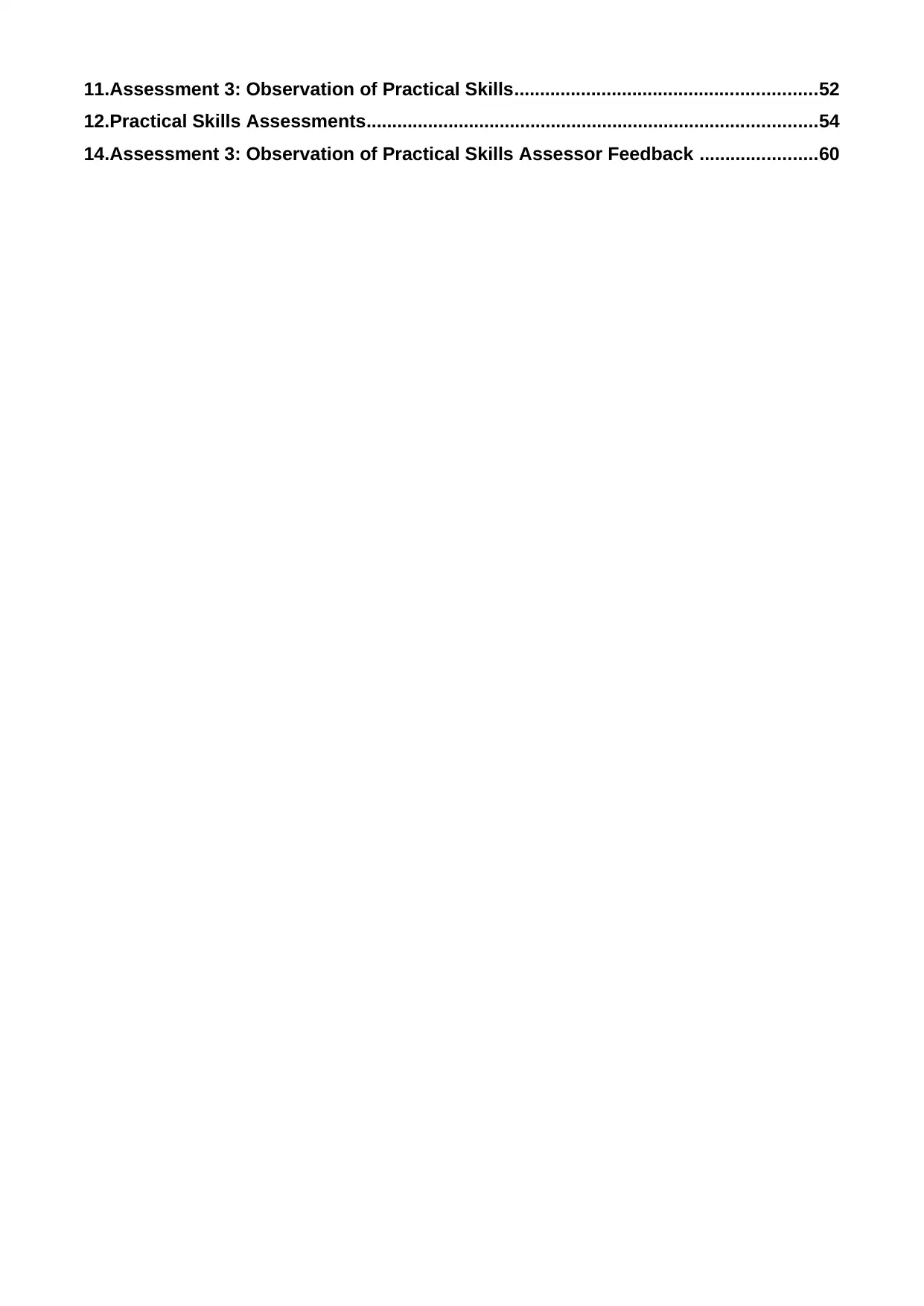
11.Assessment 3: Observation of Practical Skills...........................................................52
12.Practical Skills Assessments........................................................................................54
14.Assessment 3: Observation of Practical Skills Assessor Feedback .......................60
12.Practical Skills Assessments........................................................................................54
14.Assessment 3: Observation of Practical Skills Assessor Feedback .......................60
⊘ This is a preview!⊘
Do you want full access?
Subscribe today to unlock all pages.

Trusted by 1+ million students worldwide
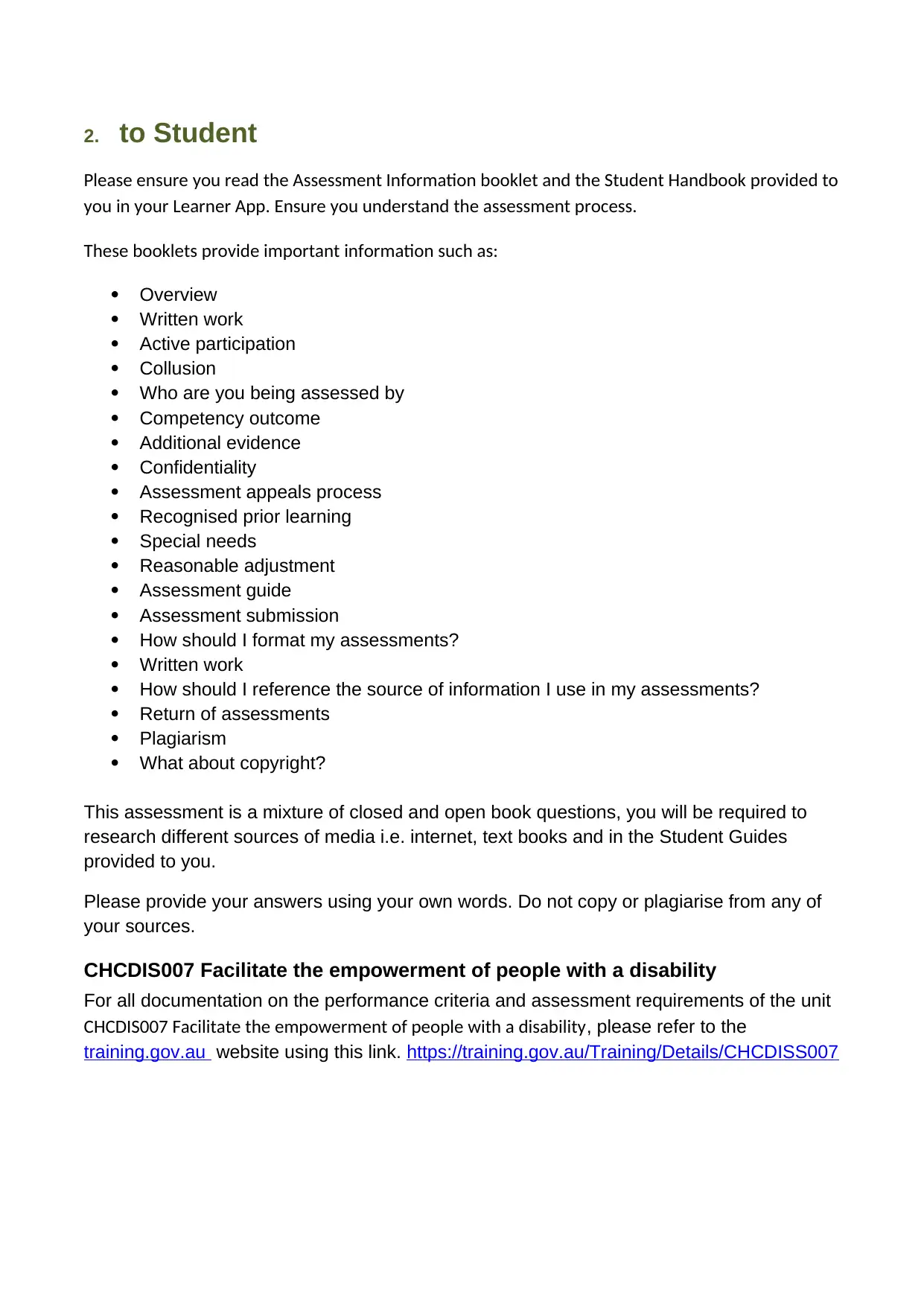
2. to Student
Please ensure you read the Assessment Information booklet and the Student Handbook provided to
you in your Learner App. Ensure you understand the assessment process.
These booklets provide important information such as:
Overview
Written work
Active participation
Collusion
Who are you being assessed by
Competency outcome
Additional evidence
Confidentiality
Assessment appeals process
Recognised prior learning
Special needs
Reasonable adjustment
Assessment guide
Assessment submission
How should I format my assessments?
Written work
How should I reference the source of information I use in my assessments?
Return of assessments
Plagiarism
What about copyright?
This assessment is a mixture of closed and open book questions, you will be required to
research different sources of media i.e. internet, text books and in the Student Guides
provided to you.
Please provide your answers using your own words. Do not copy or plagiarise from any of
your sources.
CHCDIS007 Facilitate the empowerment of people with a disability
For all documentation on the performance criteria and assessment requirements of the unit
CHCDIS007 Facilitate the empowerment of people with a disability, please refer to the
training.gov.au website using this link. https://training.gov.au/Training/Details/CHCDISS007
Please ensure you read the Assessment Information booklet and the Student Handbook provided to
you in your Learner App. Ensure you understand the assessment process.
These booklets provide important information such as:
Overview
Written work
Active participation
Collusion
Who are you being assessed by
Competency outcome
Additional evidence
Confidentiality
Assessment appeals process
Recognised prior learning
Special needs
Reasonable adjustment
Assessment guide
Assessment submission
How should I format my assessments?
Written work
How should I reference the source of information I use in my assessments?
Return of assessments
Plagiarism
What about copyright?
This assessment is a mixture of closed and open book questions, you will be required to
research different sources of media i.e. internet, text books and in the Student Guides
provided to you.
Please provide your answers using your own words. Do not copy or plagiarise from any of
your sources.
CHCDIS007 Facilitate the empowerment of people with a disability
For all documentation on the performance criteria and assessment requirements of the unit
CHCDIS007 Facilitate the empowerment of people with a disability, please refer to the
training.gov.au website using this link. https://training.gov.au/Training/Details/CHCDISS007
Paraphrase This Document
Need a fresh take? Get an instant paraphrase of this document with our AI Paraphraser


3. Student Overall Assessment Record Sheet
Unit Code and Title CHCDIS007 Facilitate the empowerment of people with a disability
Student Name
Student ID
Unit Start Date
Assessment Items
A
t
t
e
m
p
t
s
Result
S = Satisfactory
NS = Not Satisfactory
DNS = Did Not Submit
C = Competent
NC = Not Competent
Date of
Comple
tion
A
s
s
e
s
s
o
r
/
N
a
m
e
a
n
d
I
n
i
t
i
a
l
s
Assessment 1
Knowledge/skills
Assessment e.g.
Questions & Role Plays
S NS DNS
Assessment 2
(if required) Project based activities S NS DNS
Assessment 3 Simulation / Workplace
Observation S NS DNS
Final Assessment Result for this unit C N
C
Feedback to Student
Unit Code and Title CHCDIS007 Facilitate the empowerment of people with a disability
Student Name
Student ID
Unit Start Date
Assessment Items
A
t
t
e
m
p
t
s
Result
S = Satisfactory
NS = Not Satisfactory
DNS = Did Not Submit
C = Competent
NC = Not Competent
Date of
Comple
tion
A
s
s
e
s
s
o
r
/
N
a
m
e
a
n
d
I
n
i
t
i
a
l
s
Assessment 1
Knowledge/skills
Assessment e.g.
Questions & Role Plays
S NS DNS
Assessment 2
(if required) Project based activities S NS DNS
Assessment 3 Simulation / Workplace
Observation S NS DNS
Final Assessment Result for this unit C N
C
Feedback to Student
⊘ This is a preview!⊘
Do you want full access?
Subscribe today to unlock all pages.

Trusted by 1+ million students worldwide
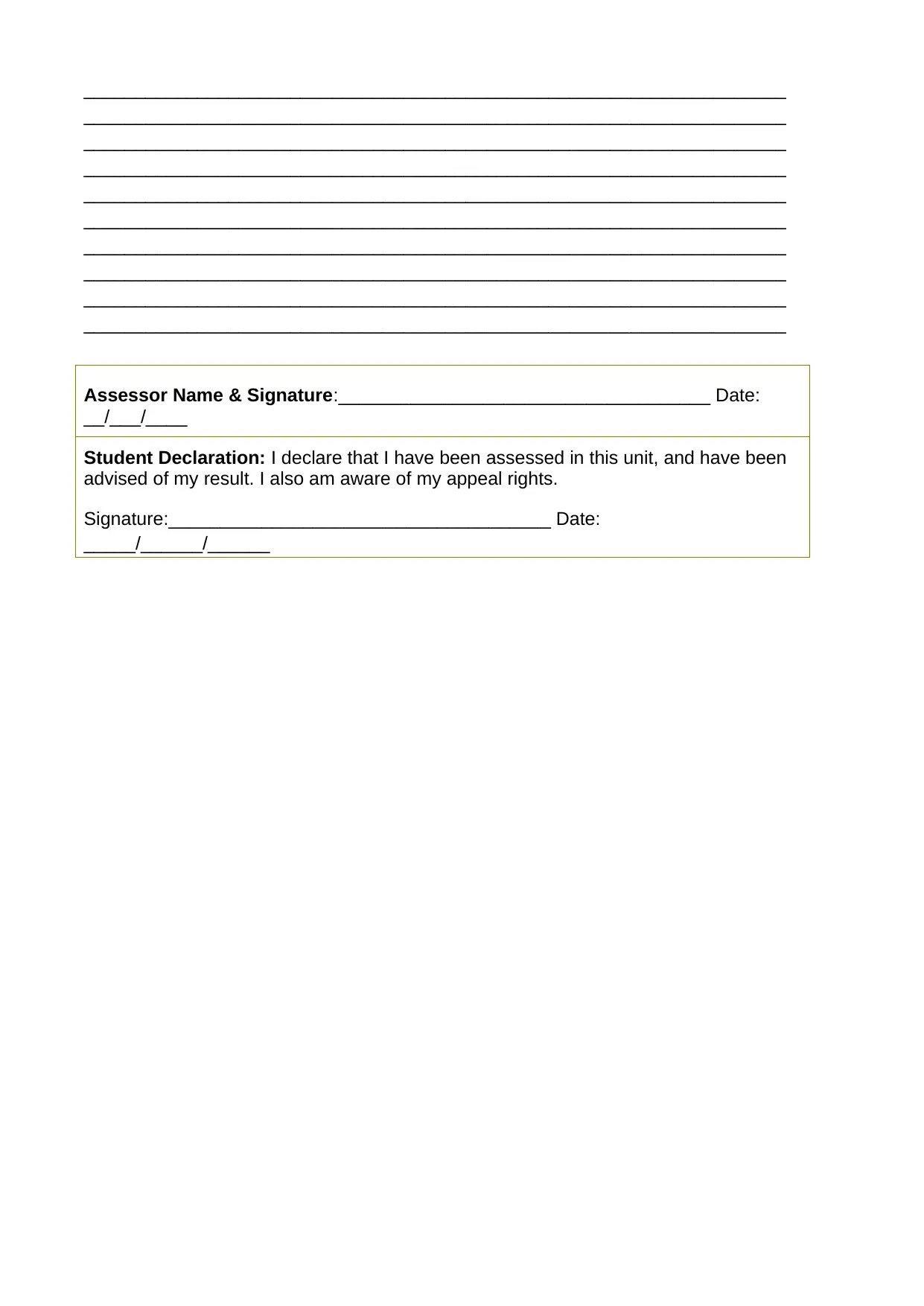
____________________________________________________________________
____________________________________________________________________
____________________________________________________________________
____________________________________________________________________
____________________________________________________________________
____________________________________________________________________
____________________________________________________________________
____________________________________________________________________
____________________________________________________________________
____________________________________________________________________
Assessor Name & Signature:____________________________________ Date:
__/___/____
Student Declaration: I declare that I have been assessed in this unit, and have been
advised of my result. I also am aware of my appeal rights.
Signature:_____________________________________ Date:
_____/______/______
____________________________________________________________________
____________________________________________________________________
____________________________________________________________________
____________________________________________________________________
____________________________________________________________________
____________________________________________________________________
____________________________________________________________________
____________________________________________________________________
____________________________________________________________________
Assessor Name & Signature:____________________________________ Date:
__/___/____
Student Declaration: I declare that I have been assessed in this unit, and have been
advised of my result. I also am aware of my appeal rights.
Signature:_____________________________________ Date:
_____/______/______
Paraphrase This Document
Need a fresh take? Get an instant paraphrase of this document with our AI Paraphraser

4. Pre Assessment Checklist
Student Name:
A
s
s
e
s
s
o
r
N
a
m
e
:
Unit Start Date:
L
o
c
a
t
i
o
n
:
Unit Code and Name
CHCDIS007 Facilitate
the empowerment of
people with a disability
Checklist for Conducting the Assessment
Student confirms readiness to be assessed
Time and date of the assessment was diarised and agreed to by the student
Unit Due Date: Time: Location:
Criteria against which the students performance will be assessed are explained to
the student
Student Name:
A
s
s
e
s
s
o
r
N
a
m
e
:
Unit Start Date:
L
o
c
a
t
i
o
n
:
Unit Code and Name
CHCDIS007 Facilitate
the empowerment of
people with a disability
Checklist for Conducting the Assessment
Student confirms readiness to be assessed
Time and date of the assessment was diarised and agreed to by the student
Unit Due Date: Time: Location:
Criteria against which the students performance will be assessed are explained to
the student
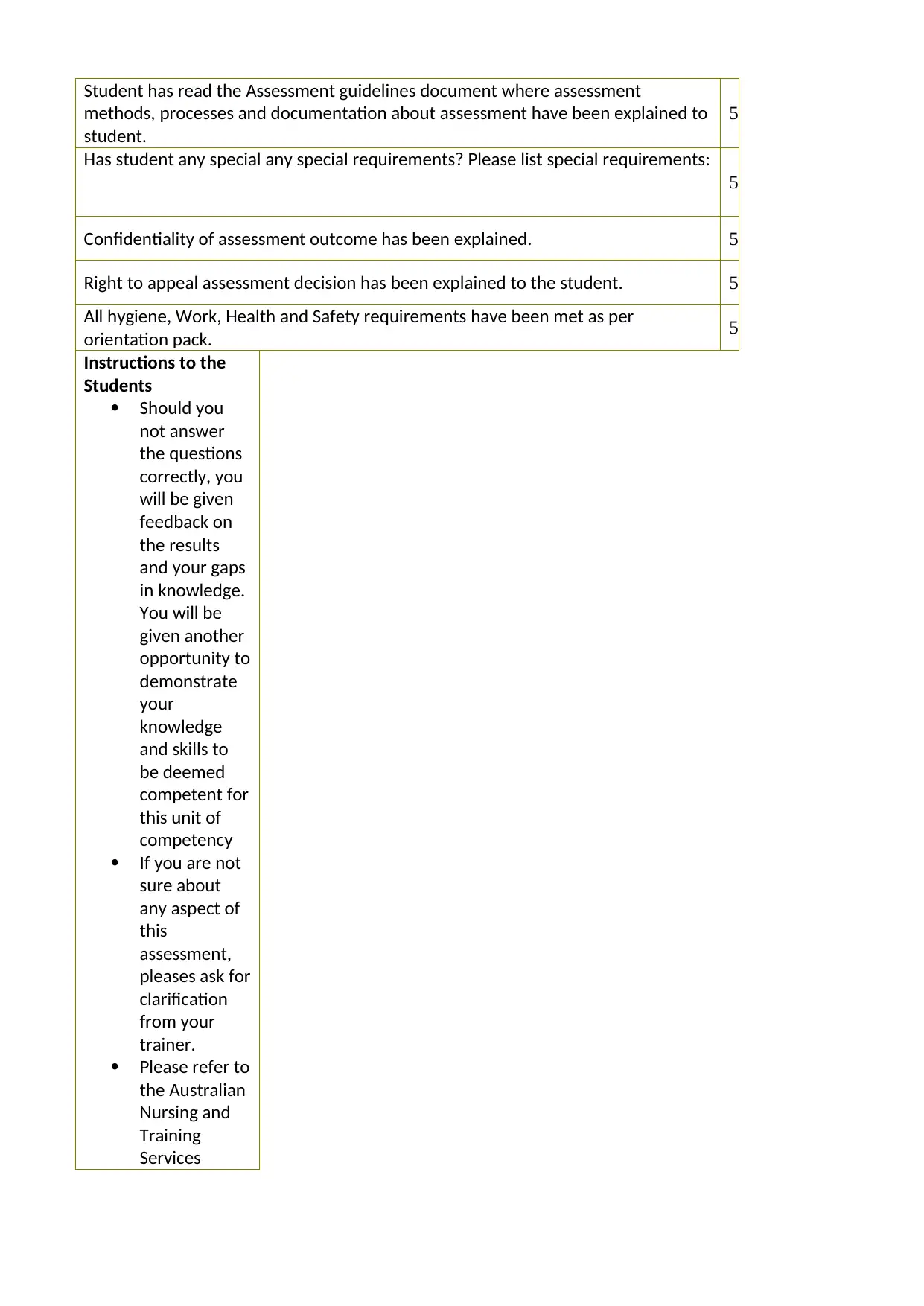
Student has read the Assessment guidelines document where assessment
methods, processes and documentation about assessment have been explained to
student.
Has student any special any special requirements? Please list special requirements:
Confidentiality of assessment outcome has been explained.
Right to appeal assessment decision has been explained to the student.
All hygiene, Work, Health and Safety requirements have been met as per
orientation pack.
Instructions to the
Students
Should you
not answer
the questions
correctly, you
will be given
feedback on
the results
and your gaps
in knowledge.
You will be
given another
opportunity to
demonstrate
your
knowledge
and skills to
be deemed
competent for
this unit of
competency
If you are not
sure about
any aspect of
this
assessment,
pleases ask for
clarification
from your
trainer.
Please refer to
the Australian
Nursing and
Training
Services
methods, processes and documentation about assessment have been explained to
student.
Has student any special any special requirements? Please list special requirements:
Confidentiality of assessment outcome has been explained.
Right to appeal assessment decision has been explained to the student.
All hygiene, Work, Health and Safety requirements have been met as per
orientation pack.
Instructions to the
Students
Should you
not answer
the questions
correctly, you
will be given
feedback on
the results
and your gaps
in knowledge.
You will be
given another
opportunity to
demonstrate
your
knowledge
and skills to
be deemed
competent for
this unit of
competency
If you are not
sure about
any aspect of
this
assessment,
pleases ask for
clarification
from your
trainer.
Please refer to
the Australian
Nursing and
Training
Services
⊘ This is a preview!⊘
Do you want full access?
Subscribe today to unlock all pages.

Trusted by 1+ million students worldwide
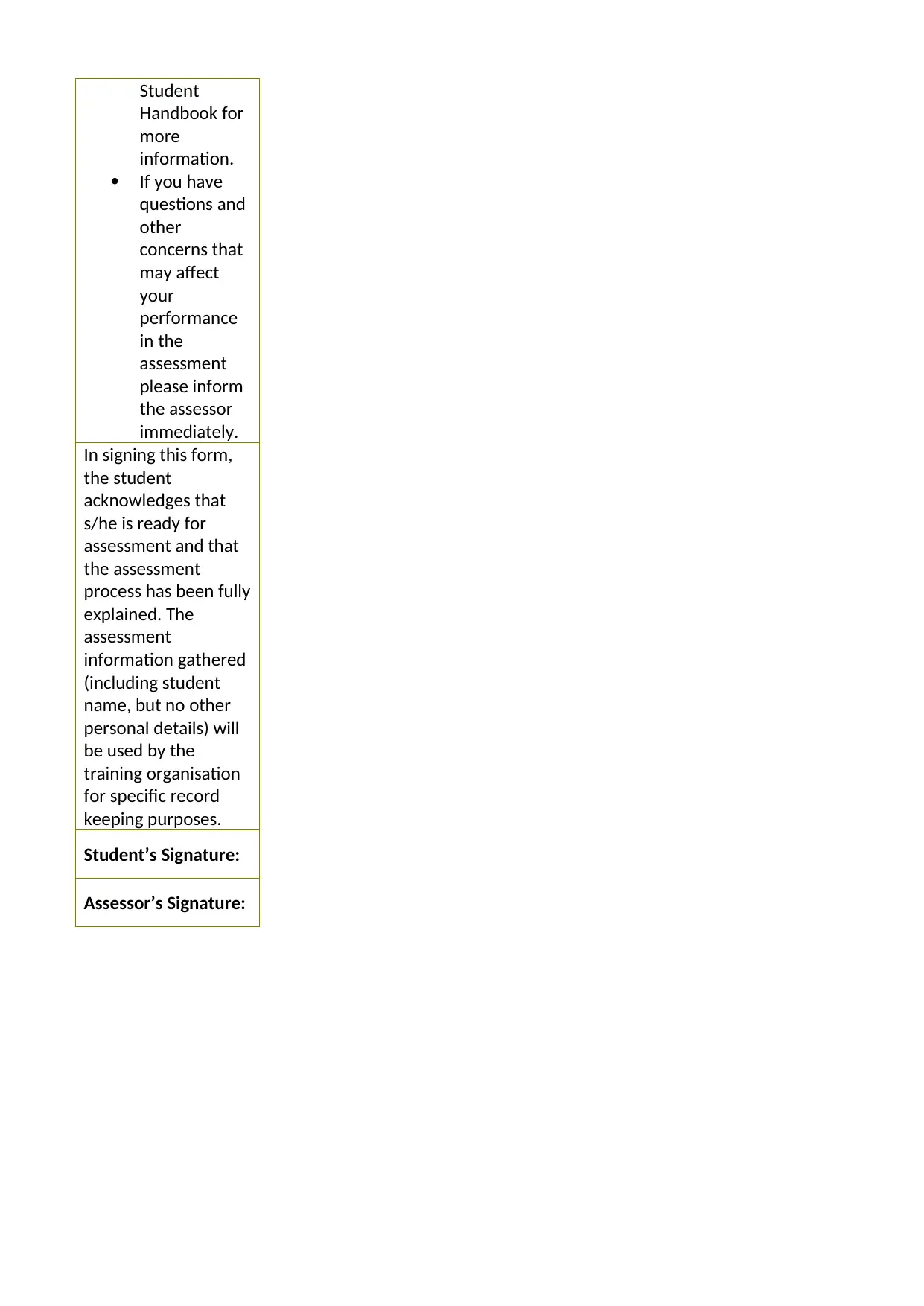
Student
Handbook for
more
information.
If you have
questions and
other
concerns that
may affect
your
performance
in the
assessment
please inform
the assessor
immediately.
In signing this form,
the student
acknowledges that
s/he is ready for
assessment and that
the assessment
process has been fully
explained. The
assessment
information gathered
(including student
name, but no other
personal details) will
be used by the
training organisation
for specific record
keeping purposes.
Student’s Signature:
Assessor’s Signature:
Handbook for
more
information.
If you have
questions and
other
concerns that
may affect
your
performance
in the
assessment
please inform
the assessor
immediately.
In signing this form,
the student
acknowledges that
s/he is ready for
assessment and that
the assessment
process has been fully
explained. The
assessment
information gathered
(including student
name, but no other
personal details) will
be used by the
training organisation
for specific record
keeping purposes.
Student’s Signature:
Assessor’s Signature:
Paraphrase This Document
Need a fresh take? Get an instant paraphrase of this document with our AI Paraphraser
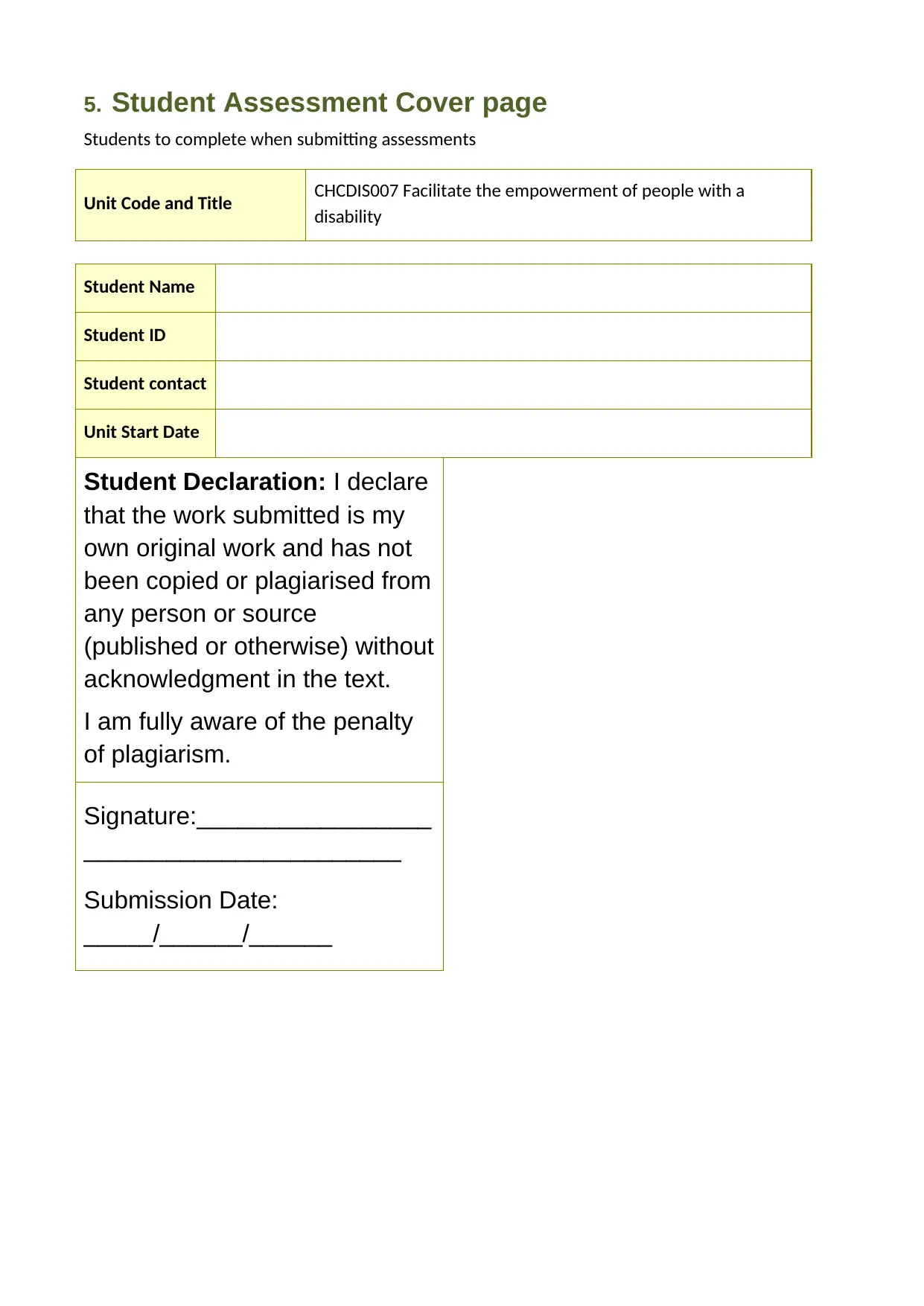
5. Student Assessment Cover page
Students to complete when submitting assessments
Unit Code and Title CHCDIS007 Facilitate the empowerment of people with a
disability
Student Name
Student ID
Student contact
Unit Start Date
Student Declaration: I declare
that the work submitted is my
own original work and has not
been copied or plagiarised from
any person or source
(published or otherwise) without
acknowledgment in the text.
I am fully aware of the penalty
of plagiarism.
Signature:_________________
_______________________
Submission Date:
_____/______/______
Students to complete when submitting assessments
Unit Code and Title CHCDIS007 Facilitate the empowerment of people with a
disability
Student Name
Student ID
Student contact
Unit Start Date
Student Declaration: I declare
that the work submitted is my
own original work and has not
been copied or plagiarised from
any person or source
(published or otherwise) without
acknowledgment in the text.
I am fully aware of the penalty
of plagiarism.
Signature:_________________
_______________________
Submission Date:
_____/______/______

⊘ This is a preview!⊘
Do you want full access?
Subscribe today to unlock all pages.

Trusted by 1+ million students worldwide
1 out of 75
Related Documents
Your All-in-One AI-Powered Toolkit for Academic Success.
+13062052269
info@desklib.com
Available 24*7 on WhatsApp / Email
![[object Object]](/_next/static/media/star-bottom.7253800d.svg)
Unlock your academic potential
Copyright © 2020–2025 A2Z Services. All Rights Reserved. Developed and managed by ZUCOL.





